-
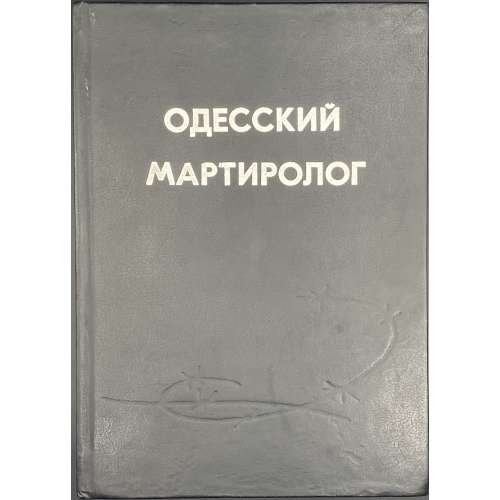 Hardcover volume, 24.2 x 17.2 cm, bound in black buckram with blind barbed wire design and silver lettering to front cover and spine, pp.: [2] 3-892 [4]. Одеський мартиролог: Данi про репресованих Одеси i Одеськоï областi за роки радянськоï влады (Серiя «Реабiлiтованi iсторiэю») (Том 3) / Уклад.: Л. В. Ковальчук, Г. О. Разумов— Одеса : ОКФА, 2005. Title-page: Научно-документальная серия книг | «РЕАБИЛИТИРОВАННЫЕ ИСТОРИЕЙ» | ОДЕССКИЙ | МАРТИРОЛОГ | ТОМ 3 | Одесса | ОКФА | 2005 || ISBN: 966-571-124-5 Print run: 1,000 copies. Ковальчук, Лидия Всеволодовна Разумов, Георгий Александрович
Hardcover volume, 24.2 x 17.2 cm, bound in black buckram with blind barbed wire design and silver lettering to front cover and spine, pp.: [2] 3-892 [4]. Одеський мартиролог: Данi про репресованих Одеси i Одеськоï областi за роки радянськоï влады (Серiя «Реабiлiтованi iсторiэю») (Том 3) / Уклад.: Л. В. Ковальчук, Г. О. Разумов— Одеса : ОКФА, 2005. Title-page: Научно-документальная серия книг | «РЕАБИЛИТИРОВАННЫЕ ИСТОРИЕЙ» | ОДЕССКИЙ | МАРТИРОЛОГ | ТОМ 3 | Одесса | ОКФА | 2005 || ISBN: 966-571-124-5 Print run: 1,000 copies. Ковальчук, Лидия Всеволодовна Разумов, Георгий Александрович -
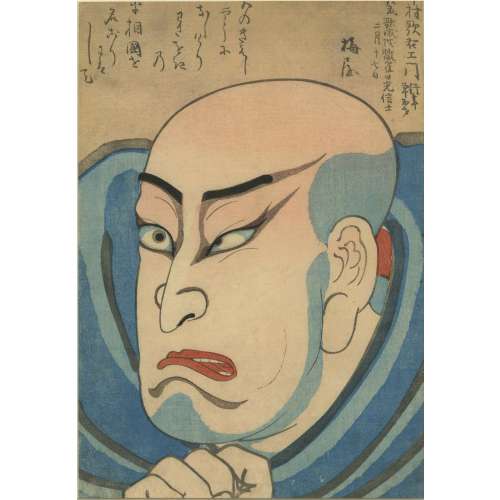 Utagawa Kuniyoshi (attributed to). Memorial portrait (Shini-e, death picture) of Nakamura Utaemon IV (a.k.a. Shikan II) as Taira no Kiyomori (1118-81). Date: 1852. Reference: [LIB-1030.2016] Robert Schaap. Heroes & ghosts: Japanese prints by Kuniyoshi, 1797-1861. — Leiden: Hotei Publishing, 1998; p. 165, image 176. [LIB-3316.2024] Chris Uhlenbeck, Jim Dwinger, Josephine Smit. The Riddles of Ukiyo-e: Women and Men in Japanese Prints. — Brussels: Ludion, 2023; pp. 242-3, № 119. Provenance: Herbert Egenolf Collection, Germany. Literature: Suzuki (1992) 317. Trimmed, unsigned.
Utagawa Kuniyoshi (attributed to). Memorial portrait (Shini-e, death picture) of Nakamura Utaemon IV (a.k.a. Shikan II) as Taira no Kiyomori (1118-81). Date: 1852. Reference: [LIB-1030.2016] Robert Schaap. Heroes & ghosts: Japanese prints by Kuniyoshi, 1797-1861. — Leiden: Hotei Publishing, 1998; p. 165, image 176. [LIB-3316.2024] Chris Uhlenbeck, Jim Dwinger, Josephine Smit. The Riddles of Ukiyo-e: Women and Men in Japanese Prints. — Brussels: Ludion, 2023; pp. 242-3, № 119. Provenance: Herbert Egenolf Collection, Germany. Literature: Suzuki (1992) 317. Trimmed, unsigned. -
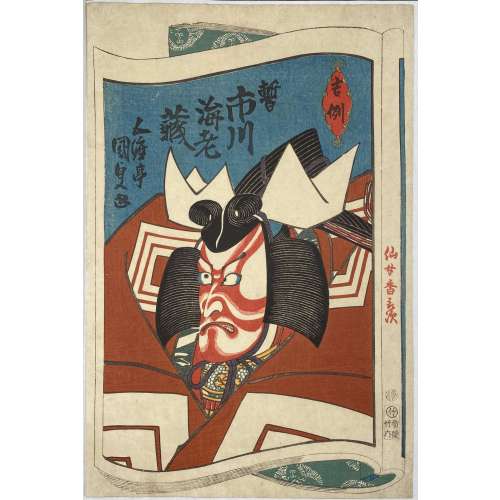 Ichikawa Ebizo V (1791 – 1859) a.k.a. Ichikawa Danjûrô VII was a great-great-great-son of Ichikawa Danjûrô I. He started his stage career in 1794, at the age of 4, playing in Shibaraku (the role he is depicted here). During his stage life, he played every role type. He was later banished from Edo for living too luxurious life for an actor. While in exile he flourished in Kioto and Osaka. Kichirei (Festive Annual Custom). Publisher: Takenouchi Magohachi (Hoeidô) Circa 1833. Description: 役者の舞台姿を描いた「舞台姿」シリーズと、日常図を描いた「千社詣」シリーズがあり、同じ役者が向かい合って対になる。(『五渡亭国貞』). Signed: Gototei Kunisada ga [五渡亭国貞画]. Censor's seal: kiwame 改印:極. Ref.: Shindo, Gototei Kunisada Yakusha-e no Sekai (1993), plate 88; Utagawa Kunisada, 150th Anniversary of His Death, Ota Memorial Museum, no. 169; MFA ACCESSION NUMBER 11.43128.
Ichikawa Ebizo V (1791 – 1859) a.k.a. Ichikawa Danjûrô VII was a great-great-great-son of Ichikawa Danjûrô I. He started his stage career in 1794, at the age of 4, playing in Shibaraku (the role he is depicted here). During his stage life, he played every role type. He was later banished from Edo for living too luxurious life for an actor. While in exile he flourished in Kioto and Osaka. Kichirei (Festive Annual Custom). Publisher: Takenouchi Magohachi (Hoeidô) Circa 1833. Description: 役者の舞台姿を描いた「舞台姿」シリーズと、日常図を描いた「千社詣」シリーズがあり、同じ役者が向かい合って対になる。(『五渡亭国貞』). Signed: Gototei Kunisada ga [五渡亭国貞画]. Censor's seal: kiwame 改印:極. Ref.: Shindo, Gototei Kunisada Yakusha-e no Sekai (1993), plate 88; Utagawa Kunisada, 150th Anniversary of His Death, Ota Memorial Museum, no. 169; MFA ACCESSION NUMBER 11.43128. -
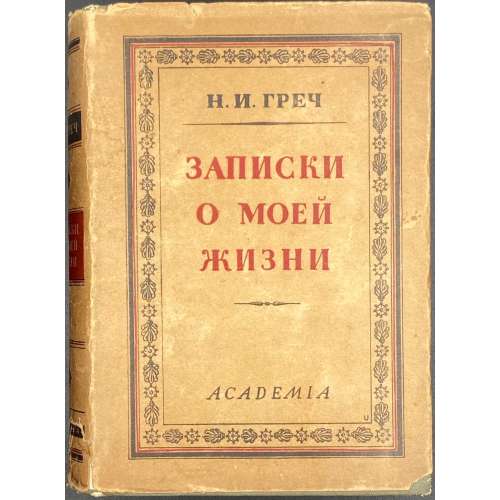 DJ: Н. И. ГРЕЧ | ЗАПИСКИ | О МОЕЙ ЖИЗНИ | ACADEMIA || Duplicate title: ПАМЯТНИКИ | ЛИТЕРАТУРНОГО | БЫТА | ЗАПИСКИ О МОЕЙ ЖИЗНИ | Н. И. ГРЕЧА | «ACADEMIA» | МОСКВА — ЛЕНИНГРАД | MCMXXX || Title page: Н. И. ГРЕЧ | ЗАПИСКИ | О МОЕЙ ЖИЗНИ | ТЕКСТ ПО РУКОПИСИ | ПОД РЕДАКЦИЕЙ | И С КОММЕНТАРИЯМИ | ИВАНОВА-РАЗУМНИКА | И Д. М. ПИНЕСА | «ACADEMIA» | МОСКВА — ЛЕНИНГРАД | MCMXXX || Title verso: ПЕРЕПЛЕТ | И СУПЕР-ОБЛОЖКА ПО РИСУНКАМ | ХУД. А. А. УШИНА | {imprint} || Pagination: [1-5] 6-896; illustrations within pagination + photomechanical frontispiece w/guard. Collation: 8vo; 1-568 (total 448 leaves + 1 plate). Binding: 18.5 x 13 cm; stamped green cloth, border to boards, elements and lettering to spine; letterpress dust jacket. Print run: 5070 copies. Catalogue raisonné: Крылов-Кичатова (2004): №402, p. 210. Contributors: Греч, Николай Иванович (Russian, 1787 – 1867) – author. Иванов-Разумник, Разумник Васильевич [Ivanov-Razoumnik] (Russian, 1878 – 1946) – editor, commentator. Пинес Дмитрий Михайлович (Russian, 1891-1937) – editor, commentator, shot by a firing squad. Ушин, Алексей Алексеевич (Russian, 1904 – 1942) – artist, died in the besieged Leningrad.
DJ: Н. И. ГРЕЧ | ЗАПИСКИ | О МОЕЙ ЖИЗНИ | ACADEMIA || Duplicate title: ПАМЯТНИКИ | ЛИТЕРАТУРНОГО | БЫТА | ЗАПИСКИ О МОЕЙ ЖИЗНИ | Н. И. ГРЕЧА | «ACADEMIA» | МОСКВА — ЛЕНИНГРАД | MCMXXX || Title page: Н. И. ГРЕЧ | ЗАПИСКИ | О МОЕЙ ЖИЗНИ | ТЕКСТ ПО РУКОПИСИ | ПОД РЕДАКЦИЕЙ | И С КОММЕНТАРИЯМИ | ИВАНОВА-РАЗУМНИКА | И Д. М. ПИНЕСА | «ACADEMIA» | МОСКВА — ЛЕНИНГРАД | MCMXXX || Title verso: ПЕРЕПЛЕТ | И СУПЕР-ОБЛОЖКА ПО РИСУНКАМ | ХУД. А. А. УШИНА | {imprint} || Pagination: [1-5] 6-896; illustrations within pagination + photomechanical frontispiece w/guard. Collation: 8vo; 1-568 (total 448 leaves + 1 plate). Binding: 18.5 x 13 cm; stamped green cloth, border to boards, elements and lettering to spine; letterpress dust jacket. Print run: 5070 copies. Catalogue raisonné: Крылов-Кичатова (2004): №402, p. 210. Contributors: Греч, Николай Иванович (Russian, 1787 – 1867) – author. Иванов-Разумник, Разумник Васильевич [Ivanov-Razoumnik] (Russian, 1878 – 1946) – editor, commentator. Пинес Дмитрий Михайлович (Russian, 1891-1937) – editor, commentator, shot by a firing squad. Ушин, Алексей Алексеевич (Russian, 1904 – 1942) – artist, died in the besieged Leningrad. -
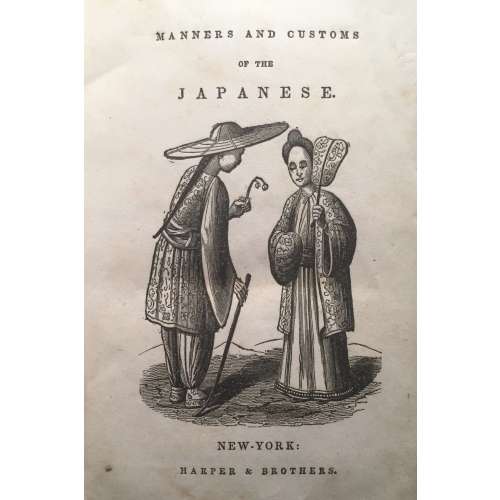
Manners and Customs of the Japanese, in the Nineteenth Century. From the Accounts of Recent Dutch Residents in Japan, and from the German Work of Dr. Ph. Fr. von Siebold.
Author: Siebold, Philipp Franz von et al.
Publisher: Harper & Brothers, New York, 1841.
-
![Э. Лиссагарэ. История Парижской Коммуны в 1871 году / С французского. Полный перевод под редакцией В. Базарова. — С.-Петербург. 1906. (Дешевая библиотека товарищества "Знание", № 274). — pp.:[4] [1] 2-524. [Проспер Оливье Лиссагарэ].](https://varshavskycollection.com/wp-content/uploads/2021/02/LIB-1158.2016-d-500x500.jpeg) Hardcover volume, collated in-8o, 21.1 x 14.9 cm, bound in half black polished morocco over green buckram boards, gilt lettering in rules to flat spine, brown diaper over cream endpapers, red ink oval library stamp in Estonian to t.p. «AJALOOMUUSEUM RAAMATUKOGU» (history museum library); pp.: [4] [1] 2-524, total 528 pages; collation π2 1-328 336, total 264 leaves. Title-page: ДЕШЕВАЯ БИБЛIОТЕКА ТОВАРИЩЕСТВА "ЗНАНIЕ". | № 274. | Э. Лиссагарэ. | ИСТОРIЯ ПАРИЖСКОЙ КОММУНЫ | въ 1871 г. | Съ французскаго. Полный переводъ | подъ редакцiей В. Базарова.| С.-ПЕТЕРБУРГЪ | 1906. || Original title: Prosper-Olivier Lissagaray. Histoire de la Commune de 1871. — Paris: E. Dentu, 1876. English translation by Eleanor Marx Aveling: [LIB-1110.2016] Prosper-Olivier Lissagaray. History of the Commune of 1871. — London: Reeves and Turner, 1886. Contributors: Hippolyte Prosper-Olivier Lissagaray (French, 1838 – 1901) – author. Владимир Александрович Базаров [Руднев, Vladimir Bazarov] (Russian, 1874 – 1939) – translator.
Hardcover volume, collated in-8o, 21.1 x 14.9 cm, bound in half black polished morocco over green buckram boards, gilt lettering in rules to flat spine, brown diaper over cream endpapers, red ink oval library stamp in Estonian to t.p. «AJALOOMUUSEUM RAAMATUKOGU» (history museum library); pp.: [4] [1] 2-524, total 528 pages; collation π2 1-328 336, total 264 leaves. Title-page: ДЕШЕВАЯ БИБЛIОТЕКА ТОВАРИЩЕСТВА "ЗНАНIЕ". | № 274. | Э. Лиссагарэ. | ИСТОРIЯ ПАРИЖСКОЙ КОММУНЫ | въ 1871 г. | Съ французскаго. Полный переводъ | подъ редакцiей В. Базарова.| С.-ПЕТЕРБУРГЪ | 1906. || Original title: Prosper-Olivier Lissagaray. Histoire de la Commune de 1871. — Paris: E. Dentu, 1876. English translation by Eleanor Marx Aveling: [LIB-1110.2016] Prosper-Olivier Lissagaray. History of the Commune of 1871. — London: Reeves and Turner, 1886. Contributors: Hippolyte Prosper-Olivier Lissagaray (French, 1838 – 1901) – author. Владимир Александрович Базаров [Руднев, Vladimir Bazarov] (Russian, 1874 – 1939) – translator. -
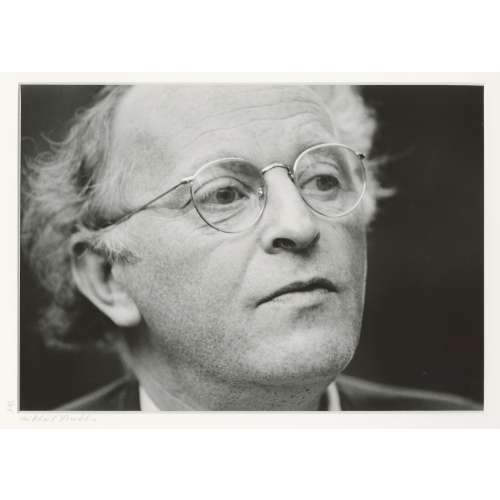 Photographic portrait of poet Joseph Brodsky, head and shoulders, three-quarters to the right, wearing glasses. Pencil-signed on the mat: 1/45 • Mikhail Lemkhin; same inscription on the back of the print, and ink stamp ©Mikhail Lemkhin. Sitter: Joseph Brodsky [Иосиф Александрович Бродский ] (Russian-American-Jewish, 1940 – 1996). Size: mat: 40.5 x 51 cm; window: 24.5 x 35 cm; print: 27.7 x 35.4 cm.
Photographic portrait of poet Joseph Brodsky, head and shoulders, three-quarters to the right, wearing glasses. Pencil-signed on the mat: 1/45 • Mikhail Lemkhin; same inscription on the back of the print, and ink stamp ©Mikhail Lemkhin. Sitter: Joseph Brodsky [Иосиф Александрович Бродский ] (Russian-American-Jewish, 1940 – 1996). Size: mat: 40.5 x 51 cm; window: 24.5 x 35 cm; print: 27.7 x 35.4 cm. -
 Richard Parkes Bonington (1802–1828 ). British/French. Evreux: Tour du Gros Horloge (Evreux: Large Clock Tower). Inscription: The tower was built in 1417 when the area was ruled by England. Lithograph. From the Taylor and Nodier set "Normandie", Vol. II, pl. 226. 1824. MET# 22.87.2. Catalogue Raisonné: Curtis 1939, no. 19. MET description: "This view in the French town of Evreux focuses on the clock tower, with vendors and customers in the street below. Bonington produced the print for the multi-volume series directed by Baron Isidore Taylor, Charles Nodier and Alphonse de Cailleux titled "Voyages Pittoresques et Romantiques dans l'Ancienne France" (Picturesque and Romantic Travels through Historic France). This image appears in volume 2, devoted to Normandy."
Richard Parkes Bonington (1802–1828 ). British/French. Evreux: Tour du Gros Horloge (Evreux: Large Clock Tower). Inscription: The tower was built in 1417 when the area was ruled by England. Lithograph. From the Taylor and Nodier set "Normandie", Vol. II, pl. 226. 1824. MET# 22.87.2. Catalogue Raisonné: Curtis 1939, no. 19. MET description: "This view in the French town of Evreux focuses on the clock tower, with vendors and customers in the street below. Bonington produced the print for the multi-volume series directed by Baron Isidore Taylor, Charles Nodier and Alphonse de Cailleux titled "Voyages Pittoresques et Romantiques dans l'Ancienne France" (Picturesque and Romantic Travels through Historic France). This image appears in volume 2, devoted to Normandy." -
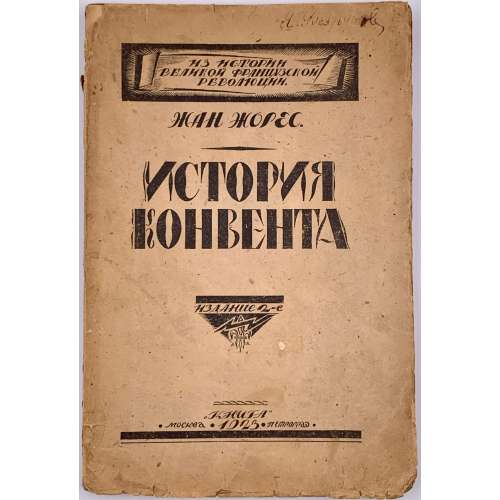 Cover: ИЗ ИСТОРИИ | ВЕЛИКОЙ ФРАНЦУЗСКОЙ | РЕВОЛЮЦИИ | ЖАН ЖОРЕС | ИСТОРИЯ КОНВЕНТА | ИЗДАНИЕ 2-е | “Книга” | • МОСКВА • 1923 • ПЕТРОГРАД • || Title page: Жан Жорес | История Конвента | Сокращенный перевод В. Левицкого | под редакцией Ф. Дана. | Второе издание. | {publisher’s device} | “Книга” | Москва. […] Петроград | Тверская, 38, тел. 2-64-61. […] Невский, 74, тел. 1-34-34. || Print run: 3,000 copies. Printer: 10-я типография МСНХ «Мосполиграф». Original Title: Histoire socialiste : 1789-1900. La convention nationale / par J. Jaurès. — Paris : Jules Rouff et Cie, 1901 Bibliographical description: 23.5 x 16 cm, publisher’s letterpress wrappers, pp. [1-3] 4-191 [192]; collation: 8vo, [1-2]8 3-128; ink inscription to front wrapper: Я. Безруков Jean Jaurès [Жан Жорес] (French, 1859 – 1914) Цедербаум, Владимир Осипович [Левицкий, В.] (Russian-Jewish, 1883 – 1938) Дан [Гурвич], Федор Ильич (Russian-Jewish, 1871-1947)
Cover: ИЗ ИСТОРИИ | ВЕЛИКОЙ ФРАНЦУЗСКОЙ | РЕВОЛЮЦИИ | ЖАН ЖОРЕС | ИСТОРИЯ КОНВЕНТА | ИЗДАНИЕ 2-е | “Книга” | • МОСКВА • 1923 • ПЕТРОГРАД • || Title page: Жан Жорес | История Конвента | Сокращенный перевод В. Левицкого | под редакцией Ф. Дана. | Второе издание. | {publisher’s device} | “Книга” | Москва. […] Петроград | Тверская, 38, тел. 2-64-61. […] Невский, 74, тел. 1-34-34. || Print run: 3,000 copies. Printer: 10-я типография МСНХ «Мосполиграф». Original Title: Histoire socialiste : 1789-1900. La convention nationale / par J. Jaurès. — Paris : Jules Rouff et Cie, 1901 Bibliographical description: 23.5 x 16 cm, publisher’s letterpress wrappers, pp. [1-3] 4-191 [192]; collation: 8vo, [1-2]8 3-128; ink inscription to front wrapper: Я. Безруков Jean Jaurès [Жан Жорес] (French, 1859 – 1914) Цедербаум, Владимир Осипович [Левицкий, В.] (Russian-Jewish, 1883 – 1938) Дан [Гурвич], Федор Ильич (Russian-Jewish, 1871-1947) -
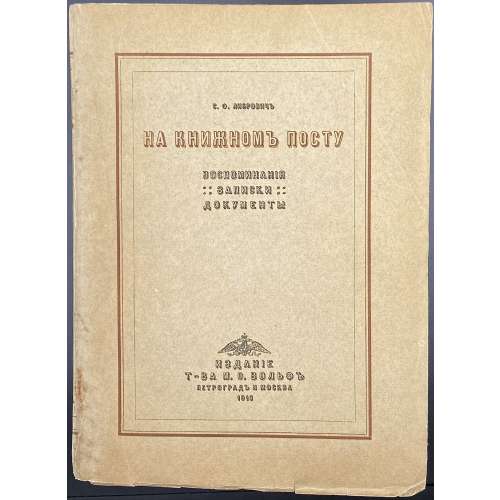 Softcover volume, 24.0 x 17.7 cm, publisher’s tan wrappers, lettered to front and spine in brown and black, publisher’s device and imprint to back, upper margin trimmed, all printed on laid paper, pp: [i-viii] [1-3] 4-496 [4], last page blank (total 508 pages); collated 8vo: π4 1-318 χ2 (total 254 leaves). Book-label with publisher’s device to fep (χ1 recto). Title-page and front wrapper (in brown and black): С. Ф. ЛИБРОВИЧЪ | НА КНИЖНОМЪ ПОСТУ | ВОСПОМИНАНIЯ | : : ЗАПИСКИ : : | ДОКУМЕНТЫ | {two-headed eagle} | ИЗДАНIЕ | Т-ВА М. О. ВОЛЬФЪ | ПЕТРОГРАДЪ И МОСКВА | (1916 on front wrapper) || Provenance: Publisher Contributors: Сигизмунд Феликсович Либрович [Zygmunt Librowicz] (Polish-Russian, 1855 – 1918) – author. Товарищество М. О. Вольф (Петроград-Москва) – publisher. Типография товарищества М. О. Вольф (Петроград) – printer. Маврикий Осипович Вольф [Maurycy Bolesław Wolff] (Polish-Russian, 1825 – 1883) – dedicatee.
Softcover volume, 24.0 x 17.7 cm, publisher’s tan wrappers, lettered to front and spine in brown and black, publisher’s device and imprint to back, upper margin trimmed, all printed on laid paper, pp: [i-viii] [1-3] 4-496 [4], last page blank (total 508 pages); collated 8vo: π4 1-318 χ2 (total 254 leaves). Book-label with publisher’s device to fep (χ1 recto). Title-page and front wrapper (in brown and black): С. Ф. ЛИБРОВИЧЪ | НА КНИЖНОМЪ ПОСТУ | ВОСПОМИНАНIЯ | : : ЗАПИСКИ : : | ДОКУМЕНТЫ | {two-headed eagle} | ИЗДАНIЕ | Т-ВА М. О. ВОЛЬФЪ | ПЕТРОГРАДЪ И МОСКВА | (1916 on front wrapper) || Provenance: Publisher Contributors: Сигизмунд Феликсович Либрович [Zygmunt Librowicz] (Polish-Russian, 1855 – 1918) – author. Товарищество М. О. Вольф (Петроград-Москва) – publisher. Типография товарищества М. О. Вольф (Петроград) – printer. Маврикий Осипович Вольф [Maurycy Bolesław Wolff] (Polish-Russian, 1825 – 1883) – dedicatee. -
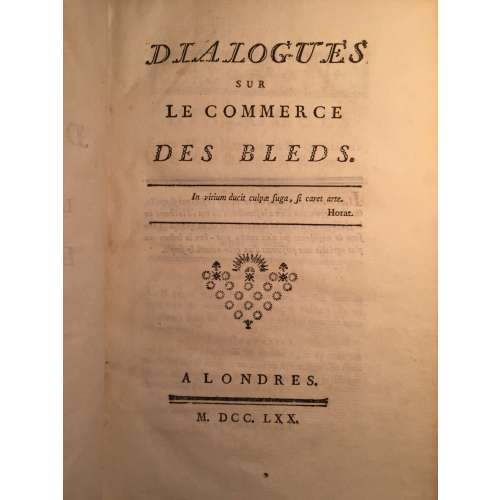
GALIANI, Ferdinando, Abbé. Dialogue sur le commerce des bleds. Londres, 1770. L'Abbé Roubaud, Pierre Joseph André. Récréations économiques ou lettres de l'auteur des représentations aux magistrats, a M. le chevalier Zanobi, principal interlocuteur des Dialogues sur le commerce des bleds; Amsterdam & Paris, Delalain, 1770. Béguillet, Edme. De principiis vegetationis et agreculturae et de causis triplicis culturae in Burgundia disquisitio physica. Auctore E.B.D. ex Societate Œconomica Lugdunensi; Divione, 1768.
-
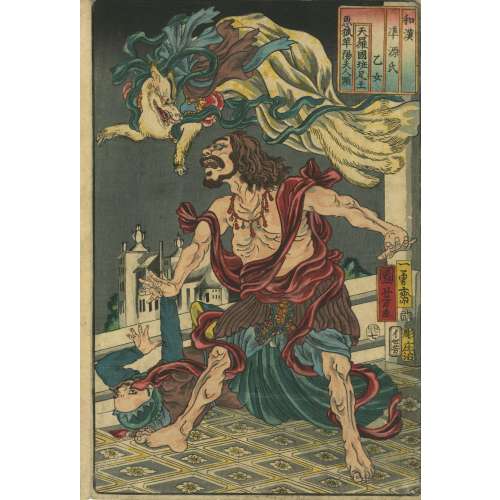 Title: Lyon Collection: Genji, Chapter 21, the maiden (otome - 乙女): the nine-tailed fox woman (kayō-fujin [花陽夫人]) terrorizing Prince Hanzoku (足王) and his servant from the series Japanese and Chinese parallels to Genji (wakan nazorae genji - 和漢准源氏). British Museum: Otome 乙女 (Maiden) / Waken nazorae Genji 和漢准源氏 (Japanese and Chinese Comparisons for the Chapters of the Genji). Schaap: Prince Hanzoku terrorized by a nine-tailed fox; Series: Wakan nazorae Genji (Japanese and Chinese parallels to Genji) Artist: Utagawa Kuniyoshi [歌川 國芳] (1798 – 1861). Publisher: Iseyoshi [伊勢芳] (Marks 25-013 | U095); seal [イせ芳]. Block carver: Hori Shōji [彫庄治] (Lyon Collection; BM); Hori Takichi [彫多吉] (Schaap). Date-aratame seal: Ansei 2, 7th month (1855). Ref: Jack Hillier. Japanese prints and drawings from the Vever Collection (3 volumes). — New York: Sotheby Parke Bernet & Rizzoli International, 1976; vol.3, p. 868, pl. 847. Robinson (1982): p. 161, S88, № 21. Schaap (1998): p. 115, № 107. SOLD
Title: Lyon Collection: Genji, Chapter 21, the maiden (otome - 乙女): the nine-tailed fox woman (kayō-fujin [花陽夫人]) terrorizing Prince Hanzoku (足王) and his servant from the series Japanese and Chinese parallels to Genji (wakan nazorae genji - 和漢准源氏). British Museum: Otome 乙女 (Maiden) / Waken nazorae Genji 和漢准源氏 (Japanese and Chinese Comparisons for the Chapters of the Genji). Schaap: Prince Hanzoku terrorized by a nine-tailed fox; Series: Wakan nazorae Genji (Japanese and Chinese parallels to Genji) Artist: Utagawa Kuniyoshi [歌川 國芳] (1798 – 1861). Publisher: Iseyoshi [伊勢芳] (Marks 25-013 | U095); seal [イせ芳]. Block carver: Hori Shōji [彫庄治] (Lyon Collection; BM); Hori Takichi [彫多吉] (Schaap). Date-aratame seal: Ansei 2, 7th month (1855). Ref: Jack Hillier. Japanese prints and drawings from the Vever Collection (3 volumes). — New York: Sotheby Parke Bernet & Rizzoli International, 1976; vol.3, p. 868, pl. 847. Robinson (1982): p. 161, S88, № 21. Schaap (1998): p. 115, № 107. SOLD -
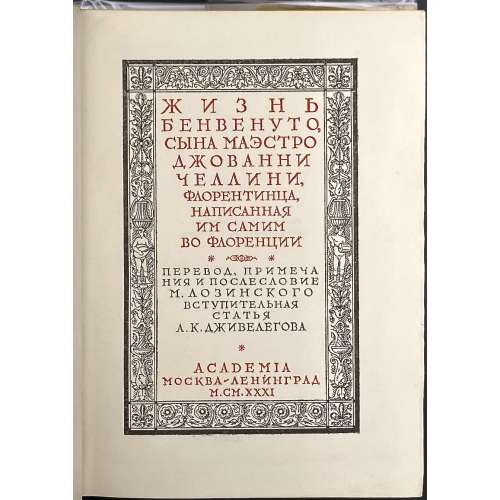 Dust jacket: Pictorial floral ornament, lettering in a central medallion: ЖИЗНЬ | БЕНВЕНУТО | ЧЕЛЛИНИ | {ACADEMIA} || Title page in black and red in a pictorial frame: ЖИЗНЬ | БЕНВЕНУТО, | СЫНА МАЭСТРО | ДЖОВАННИ | ЧЕЛЛИНИ, | ФЛОРЕНТИНЦА, | НАПИСАННАЯ | ИМ САМИМ | ВО ФЛОРЕНЦИИ |{√}| ПЕРЕВОД, ПРИМЕЧА | НИЯ И ПОСЛЕСЛОВИЕ | М. ЛОЗИНСКОГО | ВСТУПИТЕЛЬНАЯ | СТАТЬЯ | А. К. ДЖИВЕЛЕГОВА | ACADEMIA | МОСКВА~ЛЕНИНГРАД | M.CM.XXXI || Frontispiece: ПАМЯТНИКИ | ХУДОЖЕСТВЕННОГО | И ОБЩЕСТВЕННОГО | БЫТА |{√}| ЖИЗНЬ | БЕНВЕНУТО | ЧЕЛЛИНИ |{√}| ACADEMIA | МОСКВА~ЛЕНИНГРАД | M.CM.XXXI || Title verso: LA VITA DI BENVENUTO DI Mo GIOVANNI | CELLINI FIORENTINO | scritta per lui medesimo in Firenze | […] | Рисунки титулов, переплета и супер-обложки И. Ф. Реберга |[…]| 6 – 10 тысяча || Pagination: [1-5] 6-735 [736], 30 photomechanical plates (incl. portrait) Collation : [1]8 2-468 + 15 leaves of plates extraneous to collation, total 383 leaves. Binding: publisher’s burgundy cloth, gilt-stamped to front, blind-stamped to back board, gilt lettering to spine, pictorial DJ. Print run: 5,250 copies. Catalogue raisonné: Крылов-Кичатова (2004): №473, p. 220 (in 1932 section). Contributors: Benvenuto Cellini (Italian, 1500 – 1571) – author. Алексей Карпович Дживелегов (Russian, 1875 – 1952) – editor. Михаил Леонидович Лозинский (Russian, 1886 – 1955) – translator. Иван Фёдорович Рерберг (Russian, 1892 – 1957) – artist.
Dust jacket: Pictorial floral ornament, lettering in a central medallion: ЖИЗНЬ | БЕНВЕНУТО | ЧЕЛЛИНИ | {ACADEMIA} || Title page in black and red in a pictorial frame: ЖИЗНЬ | БЕНВЕНУТО, | СЫНА МАЭСТРО | ДЖОВАННИ | ЧЕЛЛИНИ, | ФЛОРЕНТИНЦА, | НАПИСАННАЯ | ИМ САМИМ | ВО ФЛОРЕНЦИИ |{√}| ПЕРЕВОД, ПРИМЕЧА | НИЯ И ПОСЛЕСЛОВИЕ | М. ЛОЗИНСКОГО | ВСТУПИТЕЛЬНАЯ | СТАТЬЯ | А. К. ДЖИВЕЛЕГОВА | ACADEMIA | МОСКВА~ЛЕНИНГРАД | M.CM.XXXI || Frontispiece: ПАМЯТНИКИ | ХУДОЖЕСТВЕННОГО | И ОБЩЕСТВЕННОГО | БЫТА |{√}| ЖИЗНЬ | БЕНВЕНУТО | ЧЕЛЛИНИ |{√}| ACADEMIA | МОСКВА~ЛЕНИНГРАД | M.CM.XXXI || Title verso: LA VITA DI BENVENUTO DI Mo GIOVANNI | CELLINI FIORENTINO | scritta per lui medesimo in Firenze | […] | Рисунки титулов, переплета и супер-обложки И. Ф. Реберга |[…]| 6 – 10 тысяча || Pagination: [1-5] 6-735 [736], 30 photomechanical plates (incl. portrait) Collation : [1]8 2-468 + 15 leaves of plates extraneous to collation, total 383 leaves. Binding: publisher’s burgundy cloth, gilt-stamped to front, blind-stamped to back board, gilt lettering to spine, pictorial DJ. Print run: 5,250 copies. Catalogue raisonné: Крылов-Кичатова (2004): №473, p. 220 (in 1932 section). Contributors: Benvenuto Cellini (Italian, 1500 – 1571) – author. Алексей Карпович Дживелегов (Russian, 1875 – 1952) – editor. Михаил Леонидович Лозинский (Russian, 1886 – 1955) – translator. Иван Фёдорович Рерберг (Russian, 1892 – 1957) – artist. -
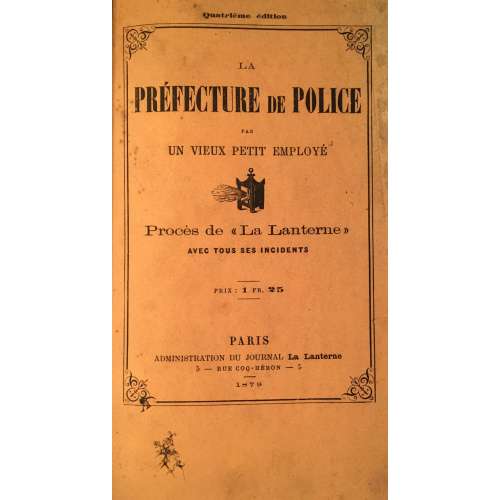
La Préfecture de Police, par un vieux petit employé - Procès de La Lanterne avec tous ses incidents. Administration du journal La Lanterne, Paris, 1879.
Quatrième édition.
Anonymous publication. Authorship attributed to: Yves Guyot, Francisque Sarcey. Source: Harvard College Library, Soc. 3375.6, 14-OCT-1914, Wolcott Fund.
-
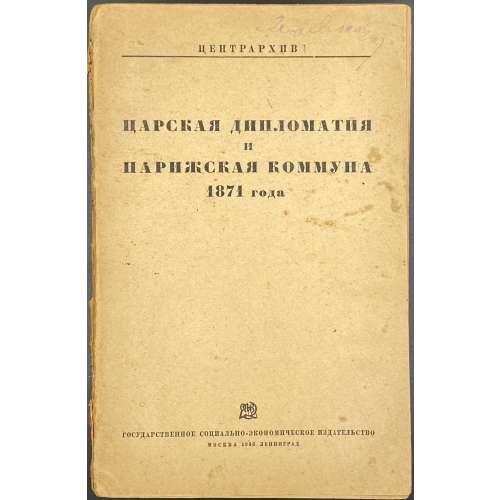 Front cover: ЦЕНТРАРХИВ | [—] | ЦАРСКАЯ ДИПЛОМАТИЯ | И | ПАРИЖСКАЯ КОММУНА | 1871 года | [blank space] [publisher's device] | ГОСУДАРСТВЕННОЕ СОЦИАЛЬНО-ЭКОНОМИЧЕСКОЕ ИЗДАТЕЛЬСТВО | МОСКВА 1933 ЛЕНИНГРАД || Title: ЦЕНТРАРХИВ | [—] | ЦАРСКАЯ ДИПЛОМАТИЯ | И | ПАРИЖСКАЯ КОММУНА | 1871 года | ПОД РЕДАКЦИЕЙ И С ПРЕДИСЛОВИЕМ | Ц. ФРИДЛЯНДА | [blank space] [publisher's device] | ГОСУДАРСТВЕННОЕ СОЦИАЛЬНО-ЭКОНОМИЧЕСКОЕ ИЗДАТЕЛЬСТВО | МОСКВА 1933 ЛЕНИНГРАД || [Центральное архивное управление при ВЦИК РСФСР]. Pagination: [2] 3-238 [2]. Softcover, editor's wrappers, lettering to covers and spine. 23 x 15 cm; Printrun (Тираж): 2000 экз.
Front cover: ЦЕНТРАРХИВ | [—] | ЦАРСКАЯ ДИПЛОМАТИЯ | И | ПАРИЖСКАЯ КОММУНА | 1871 года | [blank space] [publisher's device] | ГОСУДАРСТВЕННОЕ СОЦИАЛЬНО-ЭКОНОМИЧЕСКОЕ ИЗДАТЕЛЬСТВО | МОСКВА 1933 ЛЕНИНГРАД || Title: ЦЕНТРАРХИВ | [—] | ЦАРСКАЯ ДИПЛОМАТИЯ | И | ПАРИЖСКАЯ КОММУНА | 1871 года | ПОД РЕДАКЦИЕЙ И С ПРЕДИСЛОВИЕМ | Ц. ФРИДЛЯНДА | [blank space] [publisher's device] | ГОСУДАРСТВЕННОЕ СОЦИАЛЬНО-ЭКОНОМИЧЕСКОЕ ИЗДАТЕЛЬСТВО | МОСКВА 1933 ЛЕНИНГРАД || [Центральное архивное управление при ВЦИК РСФСР]. Pagination: [2] 3-238 [2]. Softcover, editor's wrappers, lettering to covers and spine. 23 x 15 cm; Printrun (Тираж): 2000 экз. -
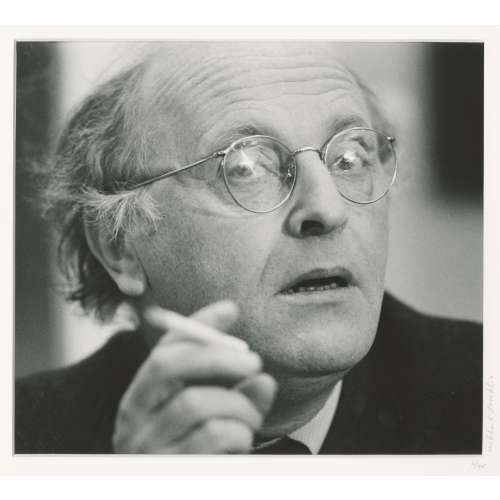 Photographic portrait of poet Joseph Brodsky, head, hand, and shoulder, three-quarters to the right, wearing glasses and with a cigarette. Pencil-signed on the mat: 4/45 • Mikhail Lemkhin; same inscription on the back of the print, and ink stamp ©Mikhail Lemkhin. Sitter: Joseph Brodsky [Иосиф Александрович Бродский ] (Russian-American-Jewish, 1940 – 1996). Size: mat: 40.5 x 51 cm; window: 26.5 x 30 cm; print: 28 x 35.4 cm.
Photographic portrait of poet Joseph Brodsky, head, hand, and shoulder, three-quarters to the right, wearing glasses and with a cigarette. Pencil-signed on the mat: 4/45 • Mikhail Lemkhin; same inscription on the back of the print, and ink stamp ©Mikhail Lemkhin. Sitter: Joseph Brodsky [Иосиф Александрович Бродский ] (Russian-American-Jewish, 1940 – 1996). Size: mat: 40.5 x 51 cm; window: 26.5 x 30 cm; print: 28 x 35.4 cm. -
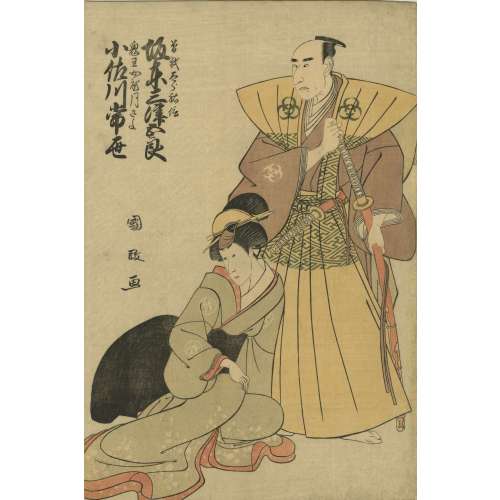 Bando Mitsugoro II as Soga no Taro Sukenobu, the step-father of the Soga brothers, and Osagawa Tsuneyo II as Onio's wife Tsukisayo, in the play 'Omonbi Kuruwa Soga' performed at the Ichimura-za in the 1st month of 1799. Reference: Harvard Art Museums accession number 1933.4.525. Publications: Narazaki Muneshige, Ukiyo-e shuka [Collection of the Masterpieces of Ukiyo-e Prints in Museums] Volume 8: Foggu Bijutsukan [Fogg Art Museum, Harvard University], Neruson Bijutsukan [Nelson Atkins Museum]..., Shogaku-kan (Tokyo, Japan, 1980 [Showa 55]), Color Plate 107; p. 104 (entry p. 191). SOLD
Bando Mitsugoro II as Soga no Taro Sukenobu, the step-father of the Soga brothers, and Osagawa Tsuneyo II as Onio's wife Tsukisayo, in the play 'Omonbi Kuruwa Soga' performed at the Ichimura-za in the 1st month of 1799. Reference: Harvard Art Museums accession number 1933.4.525. Publications: Narazaki Muneshige, Ukiyo-e shuka [Collection of the Masterpieces of Ukiyo-e Prints in Museums] Volume 8: Foggu Bijutsukan [Fogg Art Museum, Harvard University], Neruson Bijutsukan [Nelson Atkins Museum]..., Shogaku-kan (Tokyo, Japan, 1980 [Showa 55]), Color Plate 107; p. 104 (entry p. 191). SOLD -
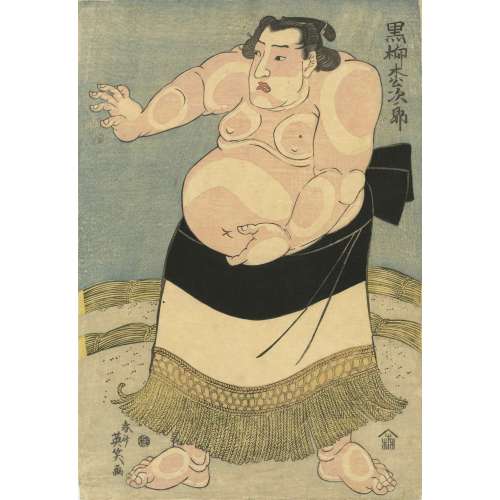 This print was sold to me with the following description: "Ikkansai EISHO (Fl. early 19th c.). A portrait of the wrestler Kuroyanagi Matsujiro, ring name Kumagatake Inosuke. Eisho was a pupil of Eishi. Published c. 1820s by Uoya Eikichi. Signed Shunsai Eisho ga." As a result of our joint effort with my beloved sister, we have so far found the following: The artis is mentioned in The Hotei Encyclopedia of Japanese Woodblock Prints, 2005, Vol 2; p. 438 under the name of Harukawa Eichō. From this source we learned that the artist was active from about 1818 till 1844, and was a print designer in Kyoto. He was a student first of Harukawa Goshichi and later studied in Edo (Tokyo) with Keisai Eisen, when he assumed the art name 'Eichō'. Other names: Shunsai. The Japanese web page dedicated to Harukawa Eichō provides more details: The artist lived from the 4th year of Tenmei ( 1784 ) to the first year of Kaei ( 1848 ). He was a student of Harukawa Goshichi, Kikukawa Eizan as well as of Keisai Eisen. His popular name was Kamenosuke. He was from Kyoto. He took "gagō" (artistic names) of Eishō when he was a student of Harukawa Goshichi; later, when he became a student of Kikukawa Eizan and Keisai Eisen he took the name of Kikukawa Eichō. The artist was mostly known for his bijinga (beautiful women) prints as well as kanazōshi illustrations. Nothing is said anywhere about his sumo prints, though the reference to another Kyushu sumo wrestler portrait has been found. The sumo wrestler Kuroyanagi Matsujiro is also a somewhat obscure figure: information about his life and career is quite inconsistent. It may so happened that two different persons were combined together. Wikipedia page about Aoi Aso Jinja, a Shinto shrine in Hitoyoshi in Kumamoto prefecture, tells us the following:This information has some inconsistencies already. If our hero was born in 1807 and promoted to ōzeki at the age of 32, it should have been the year 1839, not 1847. I found Kumagatake Isuke at "Sumo Reference" website:
This print was sold to me with the following description: "Ikkansai EISHO (Fl. early 19th c.). A portrait of the wrestler Kuroyanagi Matsujiro, ring name Kumagatake Inosuke. Eisho was a pupil of Eishi. Published c. 1820s by Uoya Eikichi. Signed Shunsai Eisho ga." As a result of our joint effort with my beloved sister, we have so far found the following: The artis is mentioned in The Hotei Encyclopedia of Japanese Woodblock Prints, 2005, Vol 2; p. 438 under the name of Harukawa Eichō. From this source we learned that the artist was active from about 1818 till 1844, and was a print designer in Kyoto. He was a student first of Harukawa Goshichi and later studied in Edo (Tokyo) with Keisai Eisen, when he assumed the art name 'Eichō'. Other names: Shunsai. The Japanese web page dedicated to Harukawa Eichō provides more details: The artist lived from the 4th year of Tenmei ( 1784 ) to the first year of Kaei ( 1848 ). He was a student of Harukawa Goshichi, Kikukawa Eizan as well as of Keisai Eisen. His popular name was Kamenosuke. He was from Kyoto. He took "gagō" (artistic names) of Eishō when he was a student of Harukawa Goshichi; later, when he became a student of Kikukawa Eizan and Keisai Eisen he took the name of Kikukawa Eichō. The artist was mostly known for his bijinga (beautiful women) prints as well as kanazōshi illustrations. Nothing is said anywhere about his sumo prints, though the reference to another Kyushu sumo wrestler portrait has been found. The sumo wrestler Kuroyanagi Matsujiro is also a somewhat obscure figure: information about his life and career is quite inconsistent. It may so happened that two different persons were combined together. Wikipedia page about Aoi Aso Jinja, a Shinto shrine in Hitoyoshi in Kumamoto prefecture, tells us the following:This information has some inconsistencies already. If our hero was born in 1807 and promoted to ōzeki at the age of 32, it should have been the year 1839, not 1847. I found Kumagatake Isuke at "Sumo Reference" website:Kuroki Matsujiro (黒木松次郎) was born in the village of Itsuki in Kuma district, Kumamoto prefecture, island of Kyushu in Bunka era, 4th year (1807). Since from his childhood he was blessed by great physique and tough strength. He had affection for sumo. At the age of 18 he became a sumo student of Kumamoto Shimakawa Ikuhei and took the name of Toyama Hidekichi (遠山日出吉). At the age of 23 (1830), he entered sumo stables in Kyoto, mastered the art of taming of young horses, and his talents improved. At the age of 31 he went to Edo, and became a disciple of the ōzeki Oitekaze Kitaro of Hirado domain in Hizen province, also from Kyushu island. After that, he changed his name and became Kuroyanagi Matsujiro (黒柳松次郎 – as on the print). In 1847 (Bunka era, 4th year) he distinguished himself by advancing to the first grade, and at the age of 32 he was promoted to ozeki level, becoming sekitori. After changing his name to Kuma-ga-take Inosuke (熊ヶ嶽猪之介 / くまがたけいのすけ) he displayed further efforts, and became one of the strongmen that fermented sumo wrestling in Edo. In 1853 (Kaei era, 6th year) he retired and returned to his village, becoming an employee as a strongman of Sagara domain (相良藩), and worked hard as instructor of the sumo training hall to train successors until 1855 (Ansei era, 2nd year) when he passed away at the age of 48. Even today Kuma-ga-take's home exists in Itsukimura (his native village). Also, on those grounds a descendant of Kuma-ga-take runs minshuku (guest house) that bears the name of "The Kuroki Pension (lodging) ", and tourists come to visit from various parts of Japan. In 2015, tenth month, within the borders of Aoi Aso Shrine there was built a gravestone publicly honoring Kuma-ga-take Inosuke, sumo wrestler from Edo / of Edo period.
The real name is the same, the ring name Kuroyanagi Matsujiro is the same, however, the date of birth here is 1815. He fought from 1836 till 1853 - which is quite similar to "At the age of 31 he went to Edo, and became a disciple of the ōzeki Oitekaze Kitaro". Though, in 1836 he might be 29 years old. His bouts are listed from spring 1841 to spring 1848 under the name of Kuroyanagi and from winter 1848 till spring 1853 he listed under the name of Kumagatake Isuke [Inosuke].Highest Rank Maegashira 4 Real Name Kuroki Birth Date 1815 Shusshin Kumamoto-ken, Kuma-gun Death Date March 6, 1855 (40 years) Heya Oitekaze Shikona Kuroyanagi Matsujiro - Kumagatake Isuke Hatsu Dohyo 1836.02 (Sandanme) Intai 1853.02 On another important sumo history website, I found that Kuroyanagi first appeared at ring in the spring of 1823 (he might have been 16 years old then, which does not seem right). Then, in the winter tournament of 1848 Kuroyanagi took the name Kumagatake. At the spring tournament of 1853 Kumagatake (Kuroyanagi) retired. This is quite consistent so far.
Then, I found Oitekaze Kitaro, allegedly the teacher of Kuroyanagi.
Everything look good with an exception of ring names (shikona): Kuroyanagi Matsujiro (1823-1828) - Kuroyanagi Sumiemon (1829-30) - Oitekaze Kitaro (1831-1839). May it be that Sato Matsutaro fought under the name of Kuroyanagi Matsujiro until Kuroki Matsujiro took this name from his master? I don't have another explanation of the enigma. What we know is that we have a portrait of a sumo wrestler called Kuroyanagi Matsujiro from Kyushu, but we don't know whether this was the one from Kumamoto (Kumagatake Inosuke, 1807/1815-1855) or the other from Kanagawa (Oitekaze Kitaro, 1799-1865). Subsequently, we may declare that the artist is Shunsai Eishō, a.k.a.Harukawa Eichō from Eishi school (The Hotei Encyclodepdia, p. 524), we can date the print from 1818 to 1844, and only tell that the wrestler is Kuroyanagi Matsujiro from Kyushu (either Kumagatake Inosuke or Oitekaze Kitaro). The publisher of the print is Moriya Jihei (Marks №353, p. 243-5). That's it.Highest Rank Ozeki Real Name SATO Matsujiro (Matsutaro#) Birth Date 1799 Shusshin Kanagawa-ken, Tsukui-gun Death Date May 4, 1865 (66 years) Heya Oitekaze Shikona Kuroyanagi Matsujiro - Kuroyanagi Sumiemon - Oitekaze Kitaro Hatsu Dohyo 1817.10 (Jonokuchi) Intai 1839.03


